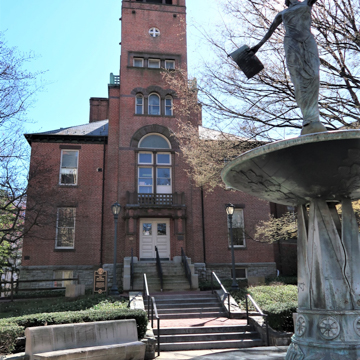The district encompasses what remains of the town’s historic commercial and governmental center surrounding the Romanesque Revival Old Red Brick Courthouse. The buildings face onto Rockville’s former main street as a reminder of earlier patterns of growth, prior to its redevelopment as the first Maryland city to take advantage of federally sponsored urban renewal funding. Beginning in 1962, much of the historic downtown was demolished for a shopping mall. Closed by 1979, the downtown was once again reimagined in the late 1990s as part of a New Urbanism design scheme. The quiet of the old town is maintained in the area that surrounds the historic courthouse by a pedestrian mall and green space.
The courthouse (1891, Frank E. Davis; 29 Courthouse Square), the third marking Rockville as the seat of Montgomery County, is built of pressed brick with rock-faced Seneca sandstone trim and distinguished by its six-story entrance tower. A classical annex (1931, Delos H. Smith and Thomas H. Edwards) was created of Indiana limestone featuring a massive projecting pedimented Ionic portico, demonstrating the changes in architectural preferences that had occurred in the ensuing decades.
The First National Bank of Maryland, built as the Farmers’ Banking and Trust Company (1930, Tilghman Moyer; 4 Courthouse Square) combines elements of classicism with Art Deco in a comprehensive design that includes elaborate interior décor as a means of attracting customers. The former U. S. Post Office (1938, R. Stanley-Brown; 2 W. Montgomery Avenue) is a Georgian Revival design, the only one of its kind in the county, erected as a Works Progress Administration (WPA) project. The hewn ashlar limestone building features a two-tiered hexagonal entrance tower and an interior mural titled Sugarloaf Mountain (1940) by Judson Smith, director of the Woodstock School of Painting.
The Beall-Dawson House (c. 1815; 103 W. Montgomery) is among the few extant buildings harkening back to the days when Rockville was coming into its own as county seat. The Federal side-hall plan house with telescoping service wing was built for Upton Beall, clerk of the Montgomery County Court. It was acquired by the Montgomery County Historical Society in 1960 to serve as its headquarters and is now a museum interpreting the lives of its original, upper-income residents and the enslaved African Americans who served them.
On the same property is the Stonestreet Museum of 19th Century Medicine. The one-room gable-front frame building ornamented with bargeboards and incised details served as the office where physician Edward Stone-street practiced medicine from 1852 to 1903.
To the east at 98 Church Street is the exuberant Queen Anne railroad station (1873, E. Francis Baldwin) for the B&O Railroad’s Metropolitan Branch that ran from Washington to Point of Rocks in Frederick County. Nearby, the former Wire Hardware (1895; 22 Baltimore Road) is the last of the nineteenth-century commercial buildings that once defined Rockville. Its cast-iron first-story shopfront is by George L. Mesker Iron Works of Evansville, Indiana.


